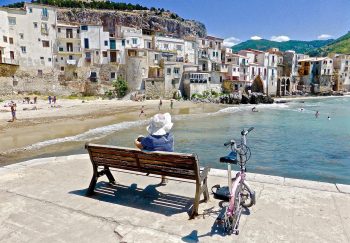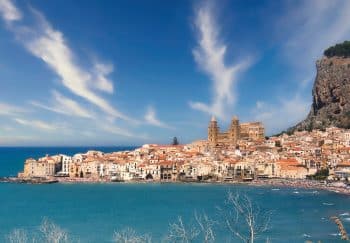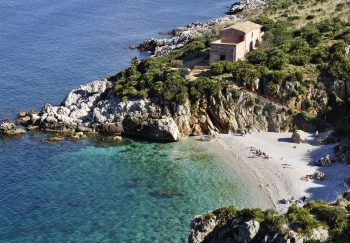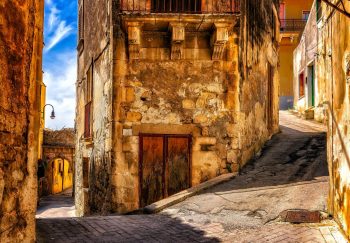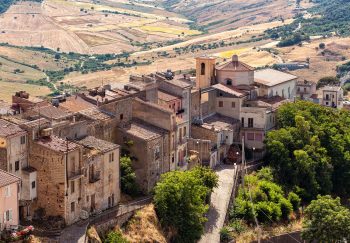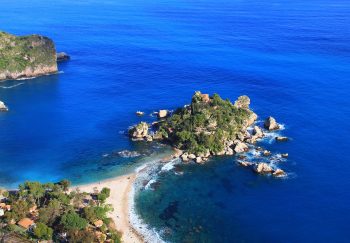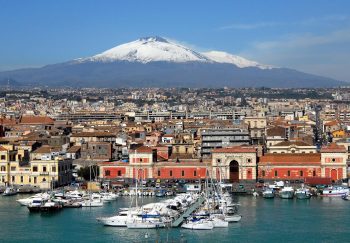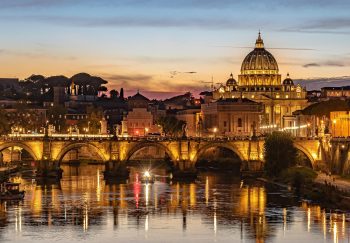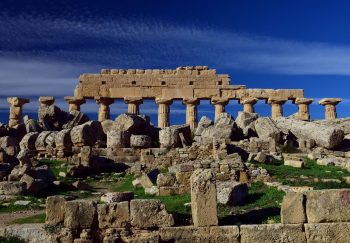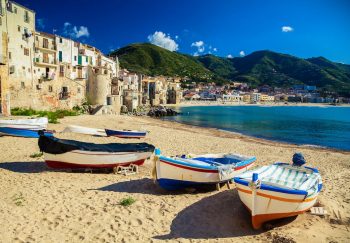Sicily is an open-air museum! Let’s go on a tour around the island to see the most significant archeological sites.
MESSINA
Let’s begin in the province of Messina. There are Villa Romana Archaeological Park and Villa Romana at Patti. 1973’s works on the highway Messina–Palermo revealed the remains of a lovely Villa Romana (from around the IV century AD). Built on the foundations of an older building, this elegant house has three main centers and a peristyle. The Antiquarium is an integral part of Villa, where you can find and preserve the finds.
Tindari can be found on the hill overlooking Patti. Let’s stop by the Archaeological Park to read Quasimodo’s “Vento a Tindari”, which is etched in the stone. Let’s take a walk among the old houses and their mosaics as well as the remains of the Agora. The theater was built by the Greeks in the III or II century BC. It is a great view of the sea, the lagoon at Marinello, and the Aeolian Islands. The Museum and the Gymnasium are not to be missed.
The Grotta St Teodoro paleontological site (Messina) takes us back approximately 12 / 13,000 year when a woman and her family lived in a natural cave 20 m high and 60 meter deep. In the 40’s, the woman’s skeleton was discovered, still intact, under a layer made of clay. The cave name is derived from the name of the woman, thea.
A few meters away from the cave are fossils of hippos, and other animals that lived in this great lake basin 200.000 years ago. Some stained glass windows preserve the partially excavated remains. A small antiquarium containing some fossilized bones (hippo’s canines and hippo’s mandibles) as well as small stone tools that were used for daily tasks such hunting or building other utensils.
We arrive at Taormina and then visit the Teatro Antico. It was constructed by the Greeks around the III Century BC. They manually removed more than 100,000 cubic meters from the mountain. The restoration of Romans, which took place in the second half of the II Century A.D., is what we see today.
Although the stage is the most important, there are no traces of columns. It is a stunning view of the Gulf of Taormina, Mount Etna and beyond. The Antiquarian is an archaeological museum located inside the theater.
An indoors theatre is the Roman Odeon located behind the Church of St. Catherine.
The Naumachia is one of the Roman works dating back to the II Century. Or, better yet, the Roman Gymnasium.
Let’s go to Taormina, enjoy the Isola Bella and then head towards the first Greek colony of Sicily: Giardini–Naxos. We can visit parts of the walls, foundations and ruins of large temples at the Archaeological Park. Park Naxos Taormina
CATANIA
Let’s now move on to Catania, which was founded by some Greek colonists from Euboea between 729 BC and 728 BC.
Piazza Stesicoro is home to a Roman amphitheater. It was probably constructed in the II Century A.D. and is located in the center of the town. This complex structure is superior to the Sicilian amphitheaters. It was constructed with lava stone and marble, and could accommodate up to 15,000 people standing or sitting. It was once used as a large naval battle pool. You can visit the Odeon as well as the Rotonda and Indirizzo thermalae.
ENNA
Let’s move on to Enna , and take Piazza Armerina out. The fancy Villa Romana del Casale is a UNESCO heritage site and a complex of beautifully preserved buildings.
It was most likely an imperial villa.
Let’s not waste any time: there are 3,500 square metres of mosaics, and 120 million pieces in a wide variety of colours. “Le ragazze bikini”, the most well-known mosaic, depicts girls in bikinis playing or competing in sports. Another less well-known mosaic is “Cubicolo dilla scena erotica”, which is the “Cubicle of the Erotic Scene”.
Villa Romana del Casale
The Morgantina is a neighboring area that contains an extensive and impressive archaeological site. This site is still being developed by archaeologists. It is evident that the Romans were skilled in constructing a water distribution system and discharge system.
It is located in a small valley between two hills. It includes the agora and the theater as well as some mosaics.
Museumof Aidone– The Dea Di Morgantina should be visited. After a dispute over its purchase by Paul Getty Museum, Malibu, the Statue was returned to it.
Another jewel is in the museum. It is fascinating to learn about the Head Of Hades, and its blue curl.
Like the fairy tale of Pollicino, a hint (in this case a curl) and the determination to an archaeologist Serena Raffiotta led to this incredible find, the Testa di Ade.
The curl was found in a case among many other findings from the Sanctuary of Demeter, Kore, and San Francesco Bisconti in Morgantina.
This was an area that grave robbers loved to target. The Superintendence intervened later and led to the discovery and identification of the site.
The head is stylistically and iconographically similar to other sculptures depicting Zeus and Dionysus from the fourth century BC, particularly for its thick hair and beard.
The Testa di Ade’s beard is responsible for the curl that shows visible traces of blue pigment. The symbolism of color refers to eternity and its assimilation into the color of sky. It also reflects the funerary connections to the gods of the underworld.
Serena Raffiotta, an archaeologist, would answer yes to our question about if she would like to be a Sicilian Indiana Jones. This is an adventure seeker of treasure and hunter for fraudulent art dealers.
Archaeological Park on izi.Travel
CALTANISSETTA
Caltanissetta The Archeological Museum in Gela is the third archeological museum in Sicily, after the Museum “Antonino Salinas”, and the Museum “Paolo Orsi” of Siracusa. It has about 5000 archaeological finds. Its collection includes many Corithian and Attic vase, a bronze helmet, a Corithian shipwreck, and an impressive collection of coins from Gela. There is also a large terracotta alter with “Medusa” as well as thirty-nine orichalcum bar, which platone stated was excavated on the atlantide island. These bars are one of the most valuable metals in ancient times.
SIRACUSA
Another UNESCO beauty is Pantalica in the Siracusa area.
It is a stunning view. It is a great place to hike. You can bring a map so you can explore the beautiful trails. The prehistoric site has thousands of rock-cut tombs that overlook the Valley of Anapo.
The Anaktoron of Pantalica is located in the middle of the hill. It is a megalithic structure found in the Acropolis of Pantalica, in the region of Sortino.
Another place to visit is Siracusa which is a UNESCO-listed heritage site. Siracusa, the oldest metropolis in the ancient Greek world, was once the capital of Sicily during the Roman and Byzantine periods.
The only wild papireti plants in Europe can be found in the waters of Fonte Aretusa and Porto Grande de Siracusa.
You will find in Ortigia the remains of the Temple Apollo, which is the God of Sun, the oldest Doric temple of Sicily.
The Cathedral in Siracusa contains the Athenanion, the most important sacred temple in the polis. It stands on the ruins a temple to Athena built in 480 BC and hides something from the past behind its doric columns that can still be seen from the outside.
Let’s move on to the Greek Theatre. It is located in the hollow of a hill with a view of the sea of Syracuse. It was built in the fifth century BC. It was instantly known for its works: Eschilio represented Etna’s Women and the Persians.
Another attraction in Siracusa is the Orecchio di Dionisio, a funnel-shaped artificial cave made of limestone. It measures 23 meters high and resembles an ear that can develop for 65m in depth. It boasts exceptional acoustic qualities: sounds can be amplified up 16 times, creating a strong echo.
Castle Eurialo is Siracusa’s most notable example of military architecture from the Greek era. It was constructed by Dionisio, a terrible tyrant, in 400BC to protect the city from the Epipoli terrace’s highest point. This means it is “above” the city.
RAGUSA
Stop in Ragusa also includes a visit at Kamarina. This is an important colony in Siracusa and a valuable archeological heritage. Today, there are only ruins left and no archaeological remains. The remains of the Temple of Athena, the agora, and other archaeological finds are preserved at the acropolis. Excavations are ongoing. Below the hill of Heracles, the remains of the walls can be found. These finds are kept in the Archaeological Museums of Kamarina Ragusa and Siracusa. The Regional Museum of Kamarina also has an area for submarine archeology.
Cava is a reference to prehistory. It’s located between Modica, and Rosolini.
It’s a long valley that runs to the sea. This is an important natural area and important archaeological site where remains of Bronze Age settlements were discovered.
AGRIGENTO
Let’s now take a deep breath. The impressive Valley of the Temples is located in Agrigento. It is one the most important sites of ancient Greek civilization. It was also included in 1998 as one of the UNESCO sites. You will find the remains of several Doric temples on a rocky ridge. They are not known to be associated with Zeus (Jupiter), Zeus (Heracles), Zeus, Concordia, Zeus (Jupiter), Zeus (Jupiter), Castor or Pollux (Dioscuri), and Hephaistos. Parco Valle dei Templi
Charming is the Garden of Kolimbethra a small garden at the heart of the Valley.
Izi Travel Guide UNESCO Sites in Sicily
Are you interested in the ancient history of Lampedusa island and the Pelagie archipelago’s Pelagie archipelago. Here’s the itinerary
TRAPANI
Trapani has ancient human settlements that date back to the prehistoric period.
Thucydides claims that the ancient Greek Segesta was established by the Elimi. This is a group of Trojan refugees who settled in Trapani in the sixth century BC. The archaeological area includes the remains of the walls, the agora and the Temple, which is one of the finest surviving examples Doric architecture, and the Greek Theatre.
Parco Archeologico Segesta
The Mazara del Vallo (Trapani) is captured in a moment ecstatic during the orgiastic dancing. There’s also the Dancing Satyr. The Museo del Satiro is located in the Church of San Egidio (1500). It houses the bronze statue. In the spring of 1997, the left limb was discovered and, on March 4, 1998, the entire body was recovered. However, it was missing both the legs and the arms. This unique monument was created by Capitan Ciccio, a Mazara fishing boat. The precious statue is not the only thing that has been revealed. There are also some maritime finds from the Strait of Sicily that remind us of emigration.
Selinunte was built by the Greeks. It was part of the rivalry against Segesta before the arrival of the Romans, who destroyed it in 250 BC. Its archaeological park is 1700 m2 – the biggest in Europe – is split into three areas: The Acropolis dedicated to worship, the Sanctuary for Demetra Malophoros which was popular at that time, and the area on the eastern hill, which is surrounded by beautiful temples and shrines.
The Island of Pantelleria is particularly significant. It contains the magnificent stone sepulchres of the Sesi civilization, the Bronze Age settlement in Mursia and the Acropolis of Saint Teresa, Saint Marco, from which three important marble heads dating back to the I century A.D. have been discovered. Giulio Cesare, Agrippina are likely to be two of the images. Pantelleria’s heads.
Let’s get on a boat to cross the Saline. We are now in Mozia. This is a small island in the Reserve Stagnone di Marsala. It was an ancient Phoenician settlement that dates back to the VIII Century BC. It was abandoned during the Roman conquest. Joseph Whitaker, an archaeologist, purchased the island in the early part of the last century and began excavations. During these excavations, remains of Punic city were discovered: its churches, places of worship and cemeteries. The museum also contains the stunning statue of the young Mozia (also known as the Auriga di Mozia and Giovinetto).
It is beautiful, and at sunset it is even more stunning. Auriga di Mozia
Marsala is home to the Baglio anselmi. This former winery houses a Museum which preserves the wreckage of a Punic vessel. The archaeological park houses a Roman-era insula. It was discovered in 1939. It’s a large building that has mosaic floors and houses a spa facility.
Favignana is located in the Egadi. It contains the former Florio delle Tonare di Favignana e Formica.
Stabilimento Florio
The Antiquarium archeological collection mainly contains amphorae from the Egadi Islands, dating back to the Greek-Roman or Punic eras.
There are also Greek-Roman and Punic lead Anchors. A flask made of pewter dating back to the 14th century was discovered in the waters around the Blu Marino in Favignana. It still contains the original wine. This rare example of a bronze rosetrum is found from the waters at Levanzo. The ancients used the rostrum to attack enemy ships. It played a major role in the Roman victory in 241 BC. In the sea of Levanzo, it was the first Punic war that ended with the defeat of the Carthaginian fleet.
In Partanna Trapani, the Castello Grifeo museum
PALERMO
You can see important remains of the Phoenicians throughout the city. The well-preserved portion of the defensive wall is located in Via del Bastione, Corso Alberto Amedeo. These walls were built in Paleapolis, which was the first Phoenician settlement. The Paleapolis grew quickly and spread to Neapolis. Some remains can be seen at the corner of Piazza Belllini, and Via Maqueda. The Necropolis was built as a second city. It is a sacred area to bury the dead. The finds that were discovered in 1746 (works continue) affect an extensive area that includes hundreds of tombs. They can be viewed at the Tukory station in Corso Calatafimi.
The Regional Archaeological Museum “Antonio Salinas” is located in Palermo. It has one of the most extensive Punic, and Greek art collections of Italy. Also, it contains many finds from Sicilian history. Antonio Salinas, Palermo’s archaeologist, and numismatic, is the museum’s founder. Among the most important pieces are the metopes of Selinunte (Temples C & E); there are also mosaics that have been removed from Villa Bonanno and Piazza Vittoria in Palermo. (Inside the villa, there is a rich collection of numismatics and the remains Roman patrician homes).
Cefala Diana’s Thermal Baths represent the only archaeological evidence that dates back to the Arab rule of Sicily. Scientists believe so.
There are also many underwater archeology.
Pantelleria Cala Tramontana , Cala Levante all have cliffs that drop into the sea. These cliffs are great for diving. You can swim only 50m from Cala Tramontana to reach the end of the trail. At 18 meters depth, there is pottery and framments made of Punic greek Italic amphorae.
Another Pantelleria landmark is Cala Gadir. This area contains cargo shipwrecks. Let’s dive near the first boa to discover the seabed. We will find a piece of a wooden boat in the water, along with some Punic and Roman amphorae, which were filmed underwater to upload the images to the internet.
In Levanzo in the Egadi Islands there is Cala Minnola. On the eastern side, we will find the remains of a Roman vessel that sank carrying a cargo full of wine amphorae.
At a depth of thirty meters, we will be able to admire the wreck and its cargo of amphorae. The wreck and its cargo of amphorae can be viewed at a depth of 30 meters.


